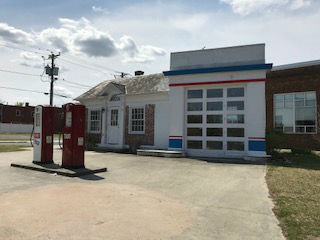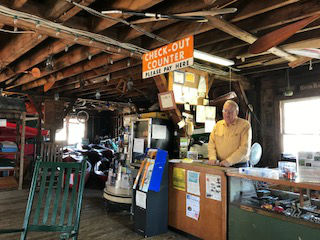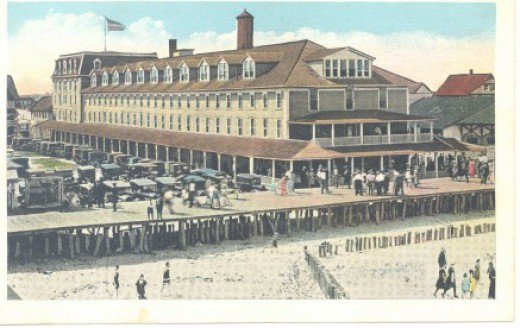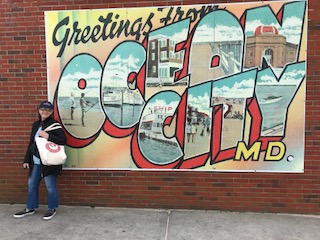Preservation Maryland supporters, Diane and Jeff Caslow, recently crossed off Worcester County on their two-year journey to visit each of Maryland’s 24 counties and Baltimore City.
MORE FROM THE CASLOW TRAVELOGUE
It is hard to believe, but we finished the 19th county on our 24 month adventure to explore each of Maryland’s counties and Baltimore City. It has been a pretty amazing adventure with my co-pilot (and husband) Jeff Caslow. This April, we decided to head to the Eastern Shore to Worcester County. “Worcester County was created by the division of Somerset County in 1742. The county seat, which was previously located near the confluence of Dividing Creek with the Pocomoke River, was later moved to the river port of Snow Hill, at the head of navigation of the Pocomoke, now near the center of the new county.” Off we went to check out the four main towns in the county from Pocomoke City to Snow Hill, Berlin and Ocean City.
Snow Hill
Snow Hill, founded in 1686 and the county seat, was our first stop and pretty quiet on a Sunday morning. However, we stayed long enough following the historic walking tour and talking to the owner of the Pocomoke River Canoe Company that the town began to wake up. The owner, Barry Laws, is a preservationist by nature as he grew up in one of the houses on the walking tour and lives in another historic home right across the street. His business is in a charming old building, where people can enjoy the Pocomoke River by kayak or canoe.
We spied an open coffee shop, The Daily Brew Coffee House, and chatted up the owner. We were then drawn into a store nearby, Brews Up, by one of the owners who invited us in to discuss beer making and suggested we come back for a stay and a class. All the businesses were great examples of giving old buildings new life. There is definitely more to explore so we will be back!
Pocomoke City
We headed southwest out of Snow Hill, following the Pocomoke River to Pocomoke City. “Beginning in the late seventeenth century, a small settlement called Stevens Landing grew at the ferry landing on the south bank of the Pocomoke River. The town was incorporated as Newtown in 1865, but was reincorporated in 1878 as Pocomoke City, after the American Indian name of the river, meaning ‘black water.'” The water gets its color from the bald cypress tree that grows along the banks. We checked out some of the historic buildings including the Sturgis One Room School, the Isaac Costen House, and the Mar-Va Theater, a 1927 restored Art Deco theater. However, I have to say that my favorite was an old gas station. Go figure.

George Island Landing
We drove straight east as I had wanted to see the southern-most point in the county across from Chincoteague Bay. George Island Landing is a beautiful spot littered with oyster shells. The nearby town, Stockton, was booming during the late 19th and early 20th centuries, it “boasted a hotel, five churches, a post office, three stores, a canning factory, two sawmills, and two barrel factories. However, the overfishing of Chincoteague Bay led to a permanent decline in the commercial seafood industry.” We can see the remains of one of the oyster packing houses from George Island Landing.
Berlin
Berlin was built in the 1790s around the original 300 acre 1677 land grant that became Burley Plantation. Main Street was originally part of the path connecting the Assateague Indians with the neighboring Pocomoke tribe. In colonial times the path became the Philadelphia Post Road, the main travel route up the shore to the centers of commerce to the north and west. It has over 40 structures on the National Register of Historic Places, and there is a historic homes self-guided walking tour. We checked out the Atlantic Hotel, most of the Main Street shops, and a local place to eat, the Burley Cafe, before we headed off to find old Ocean City.
Ocean City
Going to Ocean City in the off season is probably the best way to find and explore some of the old parts, wedged into the carnival atmosphere and throngs of beach-goers in the summer. Ocean City started as a quiet beach and fishing town with the first hotel, the Atlantic Hotel built in 1875. There are two self-guided walking tours, one for Downtown and one for Upper Downtown. We chose the Downtown tour that took us from the inlet to Third Street. Some of the places you would miss if you were not looking up from the jammed packed boardwalk stores and amusements and see the Atlantic Hotel above the fray. Others you would not even stop to marvel at, such as a ride that is over 100 years old, to appreciate its timeless and well-preserved beauty — the ca. 1902 Herschell-Spillman Carousel. A walk on the boardwalk, snap a final tourist picture and then there is one last stop on our adventure.
Glen Riddle Farm
It is only fitting that as we head into horse racing season Jeff steers us to one last place, and it is an interesting kind of preservation story. “The Community of Glen Riddle was once the most important horse training center in the nation. Called hallowed ground by some, the greatest horses of the 20th century, Man o’ War and War Admiral, once galloped where golfers now play. The stable, built to house 60 horses, is now a Ruth’s Chris Steak House restaurant.”
COUNTY-BY-COUNTY INSTALLMENTS
- November 2016: At World’s End in Cecil County
- December 2016: Washington County Bridges
- December 2016: Anne Arundel for a Capital Christmas
- February 2017: Winter Walk in Wicomico County
- March 2017: African-American History in Prince George’s County
- March 2017: Main Street March Madness in Caroline County
- April 2017: Horses and Hounds Byway through Baltimore County
- May 2017: Riding the Rails through Allegany County History
- July 2017: Howard County Historic Highlights
- August 2017: Water Moves Us to Dorchester County
- September 2017: The Stories and Storytellers of Charles County
- October 2017: Exploring the Greenery of Garrett County
- November 2017: Kent County Through Time
- December 2017: Finding History & Food in Frederick County
- January 2018:Winter Weekend in Talbot County
- February 2018: Montgomery County’s Rural Character
- March 2018: Exploring Harford County Inside and Out
- April 2018: Seeing St. Mary’s County




